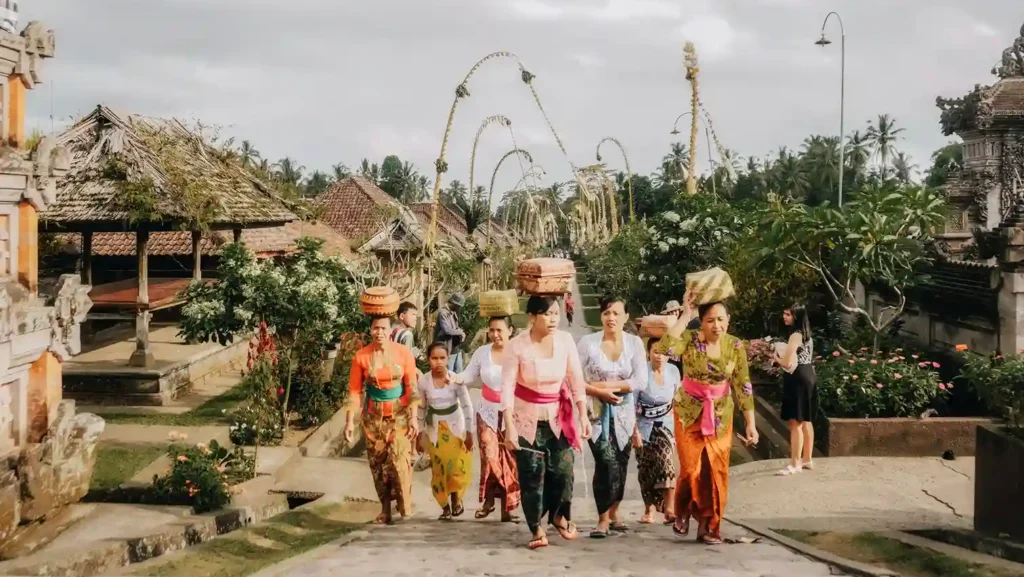Understanding Galungan and Kuningan: Essential Religious Celebrations in Bali You Must Know!
oktarina
November 18, 2025
12 min read

Did you know that Bali has a rich and meaningful religious tradition? One of the most anticipated celebrations among the Balinese Hindu community is Galungan and Kuningan. These two major holidays are not just spiritual rituals, but also an important time to strengthen bonds with family, friends, and ancestors.
If you’re interested in diving deeper into Bali’s culture, this article will give you detailed information about these two significant holidays. Let’s explore how these celebrations are observed, their meaning, and what makes them so special. By understanding Galungan and Kuningan, you’ll gain a deeper appreciation for the cultural richness of Bali, full of philosophy and traditions that have been passed down through generations. So, keep reading to find out everything you need to know about Galungan and Kuningan!
What is Galungan Day?
Galungan Day is one of the biggest celebrations in Balinese Hinduism. This celebration is extremely meaningful as it commemorates the victory of dharma (goodness) over adharma (evil). In the Balinese Hindu belief, Galungan is a special time when the spirits of ancestors return to the world to visit their families.
During Galungan, Bali’s atmosphere changes into a colorful celebration. Homes are decorated with penjor, tall bamboo poles adorned with leaves, fruits, and flowers as offerings to the gods. Various offerings like canang sari and banten are carefully prepared as a sign of gratitude and respect.
In the temples, Balinese Hindus carry out rituals with prayers that are full of meaning. Galungan is also a time for families to gather, pray together, and honor their ancestors who have passed away. The beauty and reverence of these ceremonies make Galungan a truly unforgettable moment for everyone involved.
What is Kuningan Day?
Kuningan Day marks the conclusion of the Galungan celebration, taking place 10 days after Galungan begins. During this celebration, Balinese Hindus honor their ancestors with offerings and prayers to show appreciation for their lives and contributions. Kuningan marks the end of the celebration, a time for families to gather and offer their final prayers and offerings to their ancestors before they return to the spiritual realm.
On Kuningan, the offerings are simpler than those during Galungan, yet the spiritual meaning remains very strong. Balinese Hindus prepare banten, containing flowers, fruits, and food as symbols of respect to the ancestors and gods. This day also encourages Balinese people to reflect on the balance between the physical and spiritual worlds, strengthening their connection with their ancestors.
Kuningan serves as a reminder for the Balinese to maintain harmony in their everyday lives, both physically and spiritually. It is a time for reflection and an acknowledgment of the importance of ancestors in shaping their lives. Although the Kuningan rituals are simpler, the deep respect for the ancestors is evident in every offering and prayer.
The History and Origins of Galungan and Kuningan

Both Galungan and Kuningan have deep roots in Balinese Hindu tradition and are closely tied to mythology and moral teachings. Galungan itself is based on the story in the Mahabharata, which portrays the battle between the Pandawas and the Kurawas.
In this tale, the Pandawas, representing goodness, ultimately triumph over the Kurawas, who represent evil. Galungan symbolizes the victory of dharma (goodness) over adharma (evil) and serves as a reminder for Balinese Hindus to always choose the right path in life—following noble teachings and avoiding harmful actions.
On the other hand, Kuningan, celebrated ten days after Galungan, also has its origins in Balinese mythology. On this day, the spirits of ancestors, who have returned to the world during Galungan, now rest back in the spiritual realm. Kuningan is not just the closing of the celebration, but also a symbol of perfection in balancing life between the physical and spiritual realms. It is a time for Balinese Hindus to honor and reflect on the guidance of their ancestors, as well as to contemplate the importance of balance in every aspect of life.
Overall, Galungan and Kuningan are more than just yearly rituals. They teach people to respect traditions, maintain relationships with ancestors, and preserve balance between the physical world and the spiritual world. These celebrations serve as a deep reminder that goodness must always be fought for and preserved in everyday life.
The Spiritual Meaning Behind Galungan and Kuningan
Galungan and Kuningan are not just annual celebrations for honoring tradition. These holidays carry profound spiritual meaning, giving Balinese Hindus the opportunity to reflect, improve themselves, and strengthen their relationship with God and their ancestors.
Galungan, representing the victory of goodness over evil, reminds us to always choose the right path in life. It’s a moment to reflect on our life journey, correct our flaws, and ask for blessings to be granted with wisdom, peace, and strength to face the challenges ahead.
On the other hand, Kuningan carries an even deeper meaning, honoring and celebrating the lives of our ancestors. This day teaches us to maintain close connections with the spiritual world and our ancestors, and to celebrate the legacy they left behind. Kuningan is not only the conclusion of the Galungan festivities, but also a reminder that we must live in harmony with the universe. It’s a time to reflect, be thankful for our lives, and ask for blessings from our ancestors for peace, prosperity, and happiness in the future.
Both Galungan and Kuningan give us the opportunity to deepen our relationship with God, our ancestors, and the spiritual realm. These celebrations teach us to always improve ourselves, maintain harmony with the universe, and celebrate life with gratitude and peace.
Read more: 12 Cultural Tourist Destinations in Bali You Must Visit
The Differences Between Galungan and Kuningan
| Aspect | Galungan | Kuningan |
| Focus of Celebration | Celebrating the victory of goodness (dharma) over evil (adharma). | Honoring the spirits of ancestors who return to receive offerings and prayers. |
| Timing | Celebrated every 210 days as the beginning of the series of rituals. | Celebrated 10 days after Galungan, marking the end of the celebration. |
| Spiritual Meaning | Asking for blessings and maintaining balance between the physical and spiritual realms. | Expressing gratitude to ancestors and maintaining spiritual balance. |
| Rituals and Ceremonies | Festive with penjor, canang sari, banten, and decorations decorating homes. | Simpler, focusing on prayers and offerings for ancestors. |
| Atmosphere | Lively, joyful, and bustling with family and community gatherings. | Quiet, contemplative, and introspective, focusing more on prayers and respect. |
Even though Galungan and Kuningan are part of an inseparable series of celebrations in Balinese Hindu tradition, they have distinct differences in terms of focus, timing, and the atmosphere they create. Here’s a closer look at how they differ:
1. Focus of Celebration
- Galungan: This celebration focuses on the victory of dharma (goodness) over adharma (evil). It’s a time for Balinese Hindus to seek blessings and maintain the balance between the human world and the spirit world.
- Kuningan: In contrast, Kuningan is when Balinese Hindus honor the spirits of their ancestors who return to the world to receive offerings and prayers from their families. It is a day to express gratitude for their guidance and protection.
2. Timing of the Celebration
- Galungan: Galungan is celebrated every 210 days and marks the beginning of the ritual series. It is a lively celebration, where the Balinese rejoice in the victory of goodness in their lives.
- Kuningan: Kuningan comes ten days after Galungan, and is the quieter, more introspective conclusion of the celebration. Although it holds deep meaning, the atmosphere on Kuningan is more serene and focused on honoring ancestors.
3. Spiritual Meaning
- Galungan: The spiritual significance of Galungan is to ask for blessings from the gods and maintain a harmonious balance between the physical and spiritual realms. It’s a time to renew spiritual bonds with the gods.
- Kuningan: Kuningan emphasizes gratitude and respect for the ancestors who have guided and protected their descendants. This day reminds Balinese people to maintain balance between their physical and spiritual lives.
4. Rituals and Ceremonies
- Galungan: The rituals for Galungan are vibrant and festive, featuring penjor along streets and homes, as well as offerings like canang sari and banten. The atmosphere is full of joy, with families visiting one another and celebrating.
- Kuningan: On Kuningan, the rituals are more straightforward and prayer-centered. While not as extravagant as Galungan, the spiritual depth of Kuningan is profound, with a focus on prayers and offerings.
5. Atmosphere
- Galungan: The mood of Galungan is celebratory, lively, and filled with happiness as families gather to celebrate.
- Kuningan: Kuningan offers a more tranquil and introspective atmosphere, where the focus shifts to prayer and honoring the ancestors in simplicity.
Ceremonies and Traditions During Galungan and Kuningan

Galungan and Kuningan are not just annual events but also rituals rich in spiritual and cultural meaning. During these celebrations, the people of Bali perform various ceremonies that involve the entire family and community. Below are some key traditions carried out during these holidays:
- Penjor Installation for Galungan
One of the most striking traditions during Galungan is the installation of penjor, tall bamboo poles decorated with leaves, flowers, and fruits. These penjor are placed in front of homes as a symbol of welcoming the spirits of ancestors who return to the world. - Ceremonies at the Temple during Galungan
Temples play a vital role during Galungan. People gather at temples to offer prayers and make offerings as a sign of gratitude to the gods. The ceremonies are accompanied by prayers for peace, prosperity, and protection. - Offerings and Prayers During Kuningan
Kuningan, celebrated ten days after Galungan, involves simpler offerings but still holds deep spiritual meaning. People prepare banten, including flowers, fruits, and food, as symbols of respect for their ancestors and gods. - Family and Community Harmony during Kuningan
In addition to offerings, Kuningan is a time for families to come together and strengthen their social bonds. The atmosphere is peaceful, with families sharing stories and ensuring their relationships remain harmonious.
Must-Visit Places During Galungan and Kuningan
If you want to experience Bali’s cultural richness during Galungan and Kuningan, here are some must-visit places. Each destination offers a unique spiritual and cultural experience, allowing you to explore Bali’s traditions in-depth.
- Besakih Temple
Located at the base of Gunung Agung, Besakih Temple is Bali’s largest and holiest temple. During Galungan and Kuningan, the temple becomes the center of grand ceremonies. Here, you can witness sacred rituals and experience Bali’s deep spiritual atmosphere. - Tenganan Village
Desa Tenganan, a Bali Aga village in Karangasem, is known for preserving Bali’s original traditions. During Galungan and Kuningan, the village hosts vibrant ceremonies that involve the entire community, and you can see the creation of tenun geringsing, a unique double ikat weaving technique. - Luhur Uluwatu Temple
Pura Uluwatu, perched on a cliff overlooking the Indian Ocean, offers spectacular views and sacred ceremonies during Galungan and Kuningan. While famous for its scenic beauty, the temple also provides a chance to experience Bali’s spirituality up close. - Penglipuran Village
Penglipuran village in Bangli is known for its well-preserved traditional architecture and peaceful atmosphere. During Galungan and Kuningan, the village becomes even more vibrant with rituals and offerings, providing a direct connection to Bali’s local culture.
Tips for Watching and Enjoying Galungan and Kuningan in Bali

If you plan to witness Galungan and Kuningan in Bali, here are some tips to make your experience more meaningful:
- Best Places to Watch
Pura Besakih and Pura Uluwatu are the top places to watch the ceremonies, offering magnificent views and serene rituals. For a more intimate experience, visit Desa Tenganan or Desa Penglipuran, where the local traditions are deeply rooted. - Dress Code
When visiting temples or ceremonies, dress modestly. Women should wear a kebaya, while men should wear a sarung. This shows respect for the sacred traditions of Bali. - Respect the Traditions
Galungan and Kuningan are sacred times for the Balinese, so it’s important to be respectful. Avoid loud conversations or disturbing the ceremonies. Be mindful of the quiet and reverent atmosphere. - Cultural Experience
Take the opportunity to learn more about the philosophy behind each ritual. The people of Bali are friendly and will gladly share their knowledge about Galungan and Kuningan. - Join a Custom Trip with Bali Premium Trip
For a deeper experience, consider joining a customized trip with Bali Premium Trip. Their tailored tours will take you to spiritual sites and give you a chance to explore Galungan and Kuningan in a meaningful way, guided by experts.
Read more: 8 Religious Destinations in Bali You Must Visit on Your Holiday!
Plan Your Trip to Bali with Bali Premium Trip!
Galungan and Kuningan are two significant celebrations in Bali’s Hindu tradition, rich with spiritual meaning. Galungan celebrates the victory of good over evil, while Kuningan honors ancestors and ends the ceremonial period with gratitude and peace.
To experience the beauty and meaning of Galungan and Kuningan, Bali Premium Trip offers customized trip that can be tailored to your needs. You can explore important temples like Pura Besakih, Pura Uluwatu, and traditional villages like Desa Tenganan and Desa Penglipuran, all while witnessing the profound rituals of these celebrations. With Bali Premium Trip, your journey will be comfortable, insightful, and filled with rich cultural experiences.
Don’t miss the chance to experience Bali in a unique way! Contact Bali Premium Trip now to plan an unforgettable Galungan and Kuningan journey. Our team is ready to help design a trip that suits your needs, ensuring you enjoy Bali in the most exclusive way possible!

Related Article
Bali VIP Airport Service: Relax Without the Drama at Ngurah Rai Airport
Planning a Trip to Bali? Here’s Why You Should Consider...
Planning a Trip to Bali? Here’s Why You Should Consider Bali VIP Airport Service for a Smooth and Luxurious Arrival!...
Luxury Bali Trip 2026: The Exclusive Vacation You Should Planning Now!
Have you ever imagined what it feels like to enjoy...
Have you ever imagined what it feels like to enjoy a holiday designed entirely for your comfort, without crowds and...
Year in Review: Best Bali Luxury Travel Moments in 2025
What comes to your mind when you hear the phrase...
What comes to your mind when you hear the phrase Bali Luxury Travel 2025? Many people picture quiet beaches, private...



